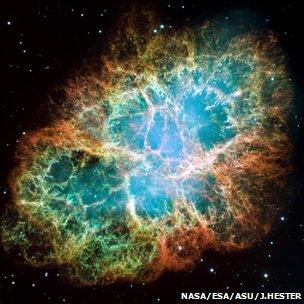Crab Nebula's gamma-ray flare mystifies astronomers
- Published

A Hubble classic: The Crab Nebula is about 6,500 light-years from Earth
The Crab Nebula has shocked astronomers by emitting an unprecedented blast of gamma rays, the highest-energy light in the Universe.
The cause of the 12 April gamma-ray flare, described at the Third Fermi Symposium in Rome, external, is a total mystery.
It seems to have come from a small area of the famous nebula, which is the wreckage from an exploded star.
The object has long been considered a steady source of light, but the Fermi telescope hints at greater activity.
The gamma-ray emission lasted for some six days, hitting levels 30 times higher than normal and varying at times from hour to hour.
While the sky abounds with light across all parts of the spectrum, Nasa's Fermi space observatory, external is designed to measure only the most energetic light: gamma rays.
These emanate from the Universe's most extreme environments and violent processes.
The Crab Nebula is composed mainly of the remnant of a supernova, which was seen on Earth to rip itself apart in the year 1054.
At the heart of the brilliantly coloured gas cloud we can see in visible light, there is a pulsar - a rapidly spinning neutron star that emits radio waves which sweep past the Earth 30 times per second. But so far none of the nebula's known components can explain the signal Fermi sees, said Roger Blandford, director of the Kavli Institute for Particle Astrophysics and Cosmology, US.
"The origin of these high-energy gamma rays has to be some other source," he told BBC News.
"It takes about six years for light to cross the nebula, so it must be a very compact region in comparison to the size of the nebula that's producing these outbursts on the time scales of hours."
Fermi has been aided by Agile, an X-ray and gamma-ray mission by the Italian Space Agency; together, they have spotted three such outbursts, with the first two reported earlier this year, external at the American Astronomical Society meeting.
These events are unleashing gamma rays with energies of more than 100 million electron-volts - that is, each packet of light, or photon, carries tens of millions of times more energy than the light we can see.
But the Crab's recent outburst is more than five times more intense than any yet observed.
'Big puzzle'
What has perplexed astronomers is that these variations in gamma rays are not matched by changes in the emission of other light "colours". Follow-up studies using the Chandra X-ray telescope, for example, showed no variations in the X-ray intensity.
Kavli Institute researcher Rolf Buehler outlined the details of the Crab's flashes to the meeting on Thursday.
"If you look in optical light, the Crab is very steady; in radio emission, it's very steady; in very, very high-energy gamma rays it's very steady. Only in this part between do we see it varying," he told BBC News.
"That's why people hadn't found this before; there was not an instrument like Fermi sensitive enough to capture it."
Understanding the flare, however, may take some time, Dr Buehler said.
"To have something that puts almost all of its energy into gamma rays is an unusual thing," he said. "We're looking at a big puzzle and are probably going to need a couple of years to understand it."
The best guess so far is that in a region near the neutron star, intense magnetic fields become opposed in direction, suddenly re-organising themselves and accelerating close-by particles to near the speed of light.
As they move in curved paths, the particles emit the gamma rays seen by Fermi.
Fermi project scientist Julie McEnery said that the find was a testament to the power of the Fermi telescope to elucidate new physics in the cosmos.
"It's just so extraordinary that so many telescopes over so many years have been looking at the Crab and it's been constant all that time, and suddenly we discover that it's not," she told BBC News.
"With Fermi, we have the opportunity to catch it when it's in this extraordinarily flaring state - it really brings home the advantage of having an instrument that looks at the whole sky all the time, because you catch the unexpected."
The US-space-agency-managed telescope was launched in 2008. It honours Enrico Fermi, the great Italian-American physicist who worked on the development of the first nuclear reactor and who was awarded the Nobel Prize in Physics in 1938 for his work on radioactivity.
- Published11 January 2011
- Published13 August 2010